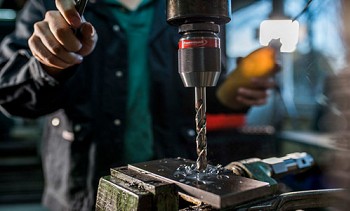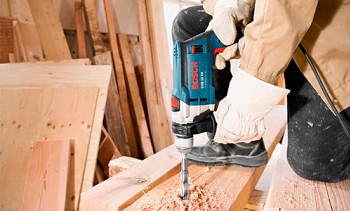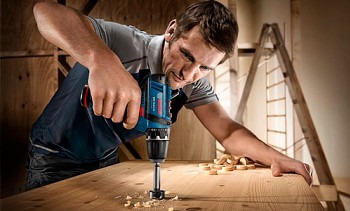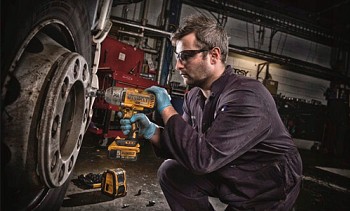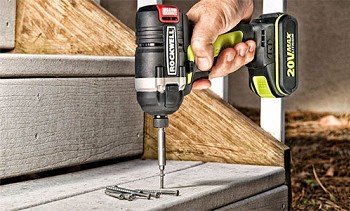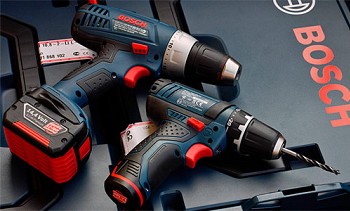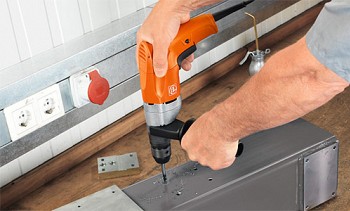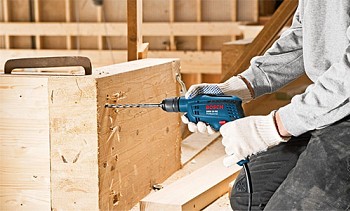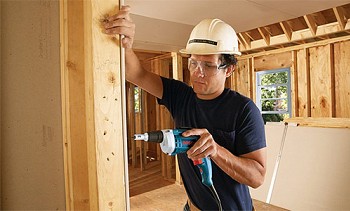A good drill can not only make holes in the walls, it is able to perform many other useful functions. Therefore, it is quite difficult for an inexperienced person to make a choice from a variety of models on the market today.
Next, we’ll talk about how to choose a drill for domestic use or for permanent use for work that fully meets specific requirements. In this case, we will take into account the estimated amount of work, as well as the functionality of the tool.
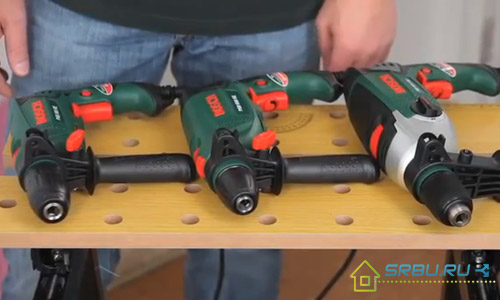
Content:
What is the difference between a professional drill and a household one
It is accepted to divide all drills into household and professional. The latter are intended for permanent use. They have a higher price, ergonomic design and not as wide a scope as household appliances. But after all, a person who needs to drill several holes only a couple of times a year does not need a tool for the “pro” at all. Amateur models can quite cope with such tasks.
Household tools are produced by all well-known manufacturers. It differs from a professional in that it is more versatile. Its price and quality indicators are harmoniously combined, and its functionality is beyond praise. But you can only work with such a drill for 4 hours during the day, periodically giving it a break. It will best be interrupted for rest after fifteen or twenty minutes of work. At the same time, the time of work and breaks should be the same.
Such a short time of continuous operation of the device is understandable. The fact is that in household models the engine is also low-power, and the materials are not the strongest. Unlike a professional tool, such drills are less protected from water and dust during operation. However, they have a lot of positive qualities.
We list them:
1. A household drill is usually universal. It can serve as a percussion instrument, and with its help you can not only drill holes, but also tighten the screws and punch a solid partition. As a rule, they are all equipped with a reverse. But “cool” professional models have a much more limited set of functions.
2. Home appliances are assembled from lightweight elements, so they weigh a little. The chuck for quick tool clamping is very convenient, there are soft pads on the case. Ergonomic appearance adds ease of use.
3. As a rule, these devices have good protection and limited power characteristics, so even an inexperienced home master will not get injured during work.
4. In a case with a drill there is a large set of components. There are spare bits, and drills, and a cartridge.
5. The guarantee of a household drill is usually higher than a professional one - two years against one.
When deciding how to choose a power drill, be aware that everything will depend on how often you intend to use the device. With not very heavy loads, home craftsmen have enough of a household appliance, and for everyday work, naturally, a professional option is needed. The passport of the device usually indicates which class it belongs to.
And yet: if the manufacturer stated that the drill can work without turning off for at least an hour, then this is clearly a tool for the “pro”. Professional devices are designed for long-term operation, throughout the entire working day, which is 7-8 hours.

What are the types of specialized drills
Despite the versatility of this tool, various modifications of drills can be structurally different from each other.This is done for greater convenience when performing certain types of work. When choosing a drill, you need to think carefully about what purposes it may be needed for. Next, we list the types of drills by their purpose.
Impact Drill
This device can be recommended for work with rather strong materials. They can pierce a concrete wall and drill a metal surface. This opportunity is created due to the fact that the axis of the device not only rotates, but also makes shocks forward and backward. This is the shock function, which, if necessary, is turned off and then normal drilling can be performed. Although not all models have the ability to turn off.
The hammer drill does not have any pneumatic type elements or a bearing called “drunk” - all of these features of a hammer drill. The principle of her work is completely different. She has inside a few gear couplings, in a connected form forming a ratchet. With effort, the couplings slide off and disconnect, releasing the axis of rotation, which begins to move forward. It is not worth trying to pierce something heavier than brick or concrete with such a drill - it will not stand it.
So such a device is adapted only for infrequent work on punching holes in concrete. This is by no means hammer drill, and with constant such loads, the drill will not last long. In addition, the impact function entails an increase in mass and backlash of the spindle, a decrease in the accuracy of conventional drilling. So universality is not always a plus, as you can see.

Impact drill with key cartridge.
Screwdriver
This device is capable of not only drilling holes, but also tightening and unscrewing screws, screws and self-tapping screws. If you need to assemble furniture, such a drill is perfect. And you can easily hang a picture on the wall with it. But if the task ahead is more serious - for example, making holes in a very durable material - then the power of such a tool may not be enough.
Screwdrivers have the following features:
- Speed adjustment;
- pulse mode;
- change in twisting force;
- reverse.

In the photo: a simple drill / driver.
Angle Drill
Everyone knows how difficult it is to drill a hole in hard-to-reach, narrow places. For such cases, an angle drill is intended. She has an angular gearbox, as a result of which the rotating shaft is perpendicular to the housing. In such devices, the shock function cannot be integrated, and their power is not very large.
Therefore, sometimes it is preferable instead of such a drill to purchase a special nozzle of the angular type. If necessary, it is worn on a regular straight drill. Therefore, when thinking about how to choose drills for drilling corner holes, it is not always necessary to look for complex and expensive options.

Drill mixer
Some universal drills are equipped with a special nozzle for mixing liquid and semi-liquid masses, up to 10 liters. There are handles on the sides of the drill / mixer, and usually comes with several attachments. The power of such devices is small, but they can work for a long time without overheating.
More powerful devices of this type have several degrees of protection, which allows you to insert and use crowns and large drills in them. An explosive-type coupling serves to increase the safety of the device - nothing will happen when it is jammed with a drill and with a person.

Cordless drill
It is used, as a rule, in those places where it is not possible to connect to the source of the electric network. The main thing that you need to pay attention to is the type of battery. Nickel cadmium batteries are not very durable and require constant operation, so they are definitely not suitable for home use, where the drill can lie on the shelf for months until it comes in handy.
Lithium-ion and metal hydride batteries last longer. As a rule, the power of such drills is not high and they are suitable for working only with soft materials.

Drill Selection Tips
Power.
So, which drill to choose for the house: a more powerful one or stop at medium parameters? The average power of these devices ranges from 500 to 900 watts. Yes, and more is not necessary if the task is not to constantly mix viscous masses or drill very large holes. But if such work is ahead, then you will have to purchase a more powerful device - only its torque will allow you to cope with the loads when drilling large and deep holes.
And another thing: keep in mind that with increasing power of the device, its weight also increases. Therefore, for ordinary work, it is quite possible to choose a drill having a power of 600-700 watts.
Shaft rotation frequency.
Such a parameter as the nominal shaft idle speed is indicated in the product passport. The higher this speed, the smoother the walls of the hole. For household appliances, high speed allows you to get more options with low power.
For grinding, polishing or impact work, increased speed is also an invaluable aid. But screw the screw is better at a speed not higher than 400 or 500 rpm. Therefore, speed control must work well.
Drilling diameter
The diameter of the maximum hole that the drill is capable of making is indicated in the passport for three different materials. These are concrete, metal and wood (sometimes only steel and wood). And percussion drills add similar characteristics to stone and brick. In this case, the diameter of the drill is also indicated. As for the minimum diameter of the resulting holes, it is usually 0.6 centimeters. The maximum can reach 30 cm when drilling with a diamond crown.
The type of drill chuck also matters.
It can be keyless or keyless. The cartridge of the last type can only be released using a special key. But it holds guaranteed, therefore, in powerful devices use just such a cartridge. He stands in impact drills - because there the load is great. This is not very convenient - the key is sometimes lost, and you have to tie it, and the gear-crown mechanism can cause injury to your hands.
Convenient quick-clamping chucks do not need an additional tool, and it is very easy to use. They also have their drawbacks: they break faster than the key ones, and they do not last so long.
Also important is such a parameter as the largest diameter of the cartridge. There are no restrictions for the minimum value - the cams of the cartridge can even converge to zero if necessary, although it is usually not necessary to compress them less than 1.5 millimeters. The maximum value of this parameter can be 16, 13 or 10 millimeters. A cartridge with a diameter of 16 millimeters is placed on powerful drills, medium-sized models are equipped with a cartridge 13, and the smallest diameter are cartridges for light drills.

Keyless chuck.

Key cartridge example.
The shaft speed switch is a useful thing.
Especially if you have to drill holes or screw the screws. After all, it is better to drill at high speed, and to tighten bolts or self-tapping screws - at low. The drill has no more than eight speeds.
Electronic gear selector
Electronic speed switch allows you to smoothly adjust them. For this, a rheostat or thyristor is used. In this case, the start button of the drill sensitively responds to pressure. If you press harder, then the speed increases, weaker - decreases. For step-by-step adjustment of rotational speed on the case there is a special switch.
In some expensive models, it is possible to stabilize the rotational speed under load. In this case, the engine power reserve is used. This function makes it possible to adjust the drill for working with specific materials, and also eliminates its jamming during overload due to a more solid structure.
Smooth start
The soft start mechanism, which is equipped with many powerful drills, accelerates the shaft from slow to high speeds.At the same time, there will be no jerks at the start, overload of the power supply and errors when drilling holes.
Button lock
Convenient function - when you turn on the start button can be fixed. This is very good - the hand holding the tool does not have to strain all the time. And you can also turn the drill into a drilling machine, if you fix it on a rack.
Little things are important too
Determining which drill to choose for your own use, you need to not only read its characteristics. You also need to hold the tool, making sure that it lies perfectly in the hand, and it will be most convenient to work with it. Look at the handle of the drill and whether it is convenient for you to hold it. After all, someone loves pens thicker, and someone - thinner. Everyone will like corrugated and non-slip pads - they are safer.
Having tried the device for weight, determine whether it is difficult to hold it. Sometimes it is very comfortable to work with a drill, in which the pistol grip is slightly biased forward.

An example of a drill with an offset handle.
And touch and switch all the knobs and buttons. They should not be tight - a smooth ride is much more pleasant and convenient. Also check if there is any play on the spindle.
If the drill can be fixed permanently in a special rack for the drill - this is a plus. Typically, the diameter of the seat for mounting in a tripod is 4.3 centimeters in diameter.

Stand for attaching a drill.
The equipment is the most important point
Thinking about how to choose the right drill, you definitely need to compare what lies in the case of the various models from which the choice is made. In addition to the drill itself - different manufacturers complete their products in different ways. If there is a spare cartridge, a depth gauge made of metal, drills - it is worth buying this particular model. After all, buying all of this separately is very expensive, especially if these are high-quality branded products. It’s better to pay immediately for the whole set - you will get significant savings.
Video: Which drill to choose

